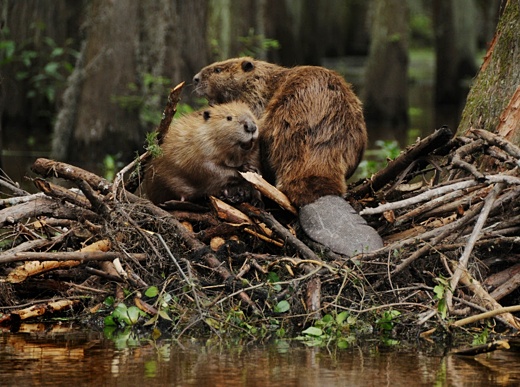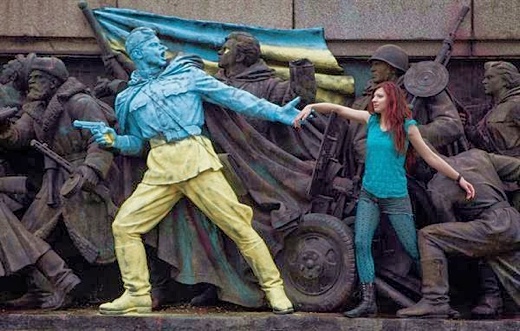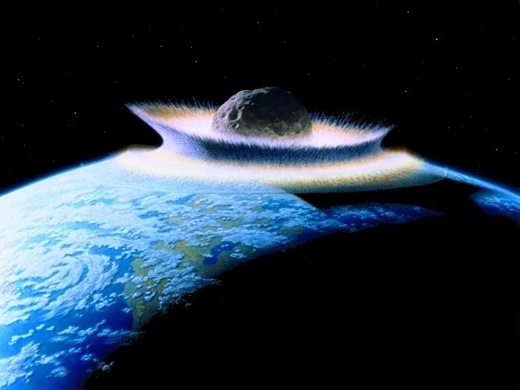SUBHEAD: A world which is richer in wildlife, will be also richer for human life.
George Monbiot interview by Jennifer Sahn on 14 February 2014 for Orion Magazine -
(
http://www.orionmagazine.org/index.php/articles/article/7966)
 Image above: A tiger in the wild is a rare thing today. Without big changes they are likely to go extinct this century. From (http://artswallpapers.com/Animals-Desktop-Wallpaper/imagepages/image121.htm).
Image above: A tiger in the wild is a rare thing today. Without big changes they are likely to go extinct this century. From (http://artswallpapers.com/Animals-Desktop-Wallpaper/imagepages/image121.htm).
One day, the British environmental writer George Monbiot was digging in his garden when he had a revelation—that his life had become too tidy and constrained. While exploring what it would take to re-ignite his own sense of wonder, he waded into a sea of ideas about restoration and rewilding that so captured his imagination that it became the focus of his next book.
Feral: Searching for Enchantment on the Frontiers of Rewilding was published in the United Kingdom in 2013, to much acclaim, and is forthcoming in the U.S. in 2014.
Orion editor Jennifer Sahn caught up with Monbiot to talk about rewilding—what it means for people, for nature, and for an environmental movement that is in great need of having far wider appeal.
Jennifer Sahn: It’s sort of an obvious starting place, but I think it makes sense to begin by asking how you define rewilding.
George Monbiot: Actually, there are two definitions of rewilding that appeal to me. One is the mass restoration of ecosystems. By restoration, I really mean bringing back their trophic function. Trophic function involves feeding. It’s about eating and being eaten.
Trophic function is the interactions between animals and plants in the food chain. Most of our ecosystems are very impoverished as far as those interactions are concerned. They’re missing the top predators and the big herbivores, and so they’re missing a lot of their ecological dynamism. That, above all, is what I want to restore.
I see the mass restoration of ecosystems, meaning taking down the fences, blocking up the drainage ditches, enabling wildlife to spread. Reintroducing missing species, and particularly missing species which are keystone species, or ecosystem engineers. These are species which have impacts greater than their biomass alone would suggest. They create habitats, and create opportunities for many other species.
Good examples would be beavers, wolves, wild boar, elephants, whales—all of which have huge ramifying effects on the ecosystem, including parts of the ecosystem with which they have no direct contact.
Otherwise, I see humans having very little continuing management role in the ecosystem. Having brought back the elements which can restore that dynamism, we then step back and stop trying to interfere.
That, in a way, is the hardest thing of all—to stop believing that, without our help, everything’s going to go horribly wrong. I think in many ways we still suffer from the biblical myth of dominion where we see ourselves as the guardians or the stewards of the planet, whereas I think it does best when we have as little influence as we can get away with.
The other definition of rewilding that interests me is the rewilding of our own lives. I believe the two processes are closely intertwined—if we have spaces on our doorsteps in which nature is allowed to do its own thing, in which it can be to some extent self-willed, driven by its own dynamic processes, that, I feel, is a much more exciting and thrilling ecosystem to explore and discover, and it enables us to enrich our lives, to fill them with wonder and enchantment.
Jennifer: So you’re using rewilding in part as a reflexive verb?
George: Absolutely. Of all the species that need rewilding, I think human beings come at the top of the list. I would love to see a more intense and emotional engagement of human beings with the living world.
The process of rewilding the ecosystem gives us an opportunity to make our lives richer and rawer than they tend to be in our very crowded and overcivilized and buttoned-down societies. That means giving ourselves time to go out and explore rewilded habitats, and delight in the spectacles they present to us.
Rewilding is very much not about excluding people. It’s about trying to re-engage people with the natural world.
Now, I’m not suggesting that people give up their houses, give up their jobs, give up their comforts. I’m suggesting that when they want to, they can step into a much more thrilling and enchanting world than surrounds us at the moment.
Jennifer: Nobody’s going back to the Stone Age, then?
George: I do not see rewilding as going back anywhere. The ecosystems that would emerge on rewilded land, or in rewilded seas, would not be the same as the ecosystems of the past—partly because we have irredeemably lost a lot of species, partly because we have changed the physical environment through climate change, through soil depletion, through the acidification of the oceans and acid rain and many other impacts.
Also, it wouldn’t be a fixed ecosystem or a fixed assemblage of species. It would be one which continued to go through dynamic, successional changes for the rest of time.
Jennifer: Your book Feral
seems to have captured the imagination of readers, whether they agree with what you are saying or not. Why do you think the notion of rewilding has been so provocative?
George: My sense is that people like me are ecologically bored, that we possess the psychological equipment required to navigate a world that is far more challenging than our own—a world of horns and tusks and fangs and claws. Yet our lives have been reduced to the point at which loading the dishwasher seems to present an interesting challenge.
Having lived for some time with people who are much closer to the living planet—indigenous people in South America, in East Africa, and in West Papua—I’ve found my own life by comparison to seem quite a small and shuffling thing. I think all of us have a sense that we’re not quite fulfilling our potential as the human beings who evolved in this really quite thrilling and exciting and dangerous environment, and that our lives are a bit too small and too constrained.
I think rewilding, or certainly the version of it that I’ve been suggesting, has appealed to people both because it gives hope, in that we can reverse some of the horrible destructive processes of which we’re all aware, but also because it introduces into our lives this element of wonder and delight which is too often missing.
Jennifer: I was rather enamored with the chart in the center of the book that lists the animals now absent from Britain and ranks their likeliness as candidates for reintroduction. It really brought the notion of rewilding to life for me. I’m curious to know about your experience compiling that chart.
George: I must say I greatly enjoyed it. I’m the sort of person who enjoys compiling lists, and that probably says more about me than is entirely comfortable. But that list was a delight to compile because it focused my mind on what we could achieve. It also helped me to get a better grasp of what was once here.
There are plenty of species on there which people are perfectly familiar with as having previously lived in Britain, like beavers and wild boar and wild horses. And some people are aware that there were lynx and bison and moose.
Wolves—people kind of know that they were here, but most people imagine that they were here thousands of years ago, whereas the last one was killed in 1621, or possibly later than that. But when you start getting to lions and hyenas and elephants and hippos, people are absolutely astonished to discover that they lived in this country.
Trafalgar Square, when that was excavated, the gravels there were absolutely full of hippopotamus bones. There once were hippos wallowing in those rivers — the same species that lived in Africa. Gray whales were very common all around the shores of Britain.
European sturgeon, these enormous creatures which would get up to eighteen feet long or so, ran up our rivers. People, even a lot of the professionals I talk to, are amazed at the number of species which were once native here.
Jennifer: It’s amazing to think about all those skeletons buried in the gravel. . .
George: Yes. Well, we tend to think of elephants, rhinos, lions, hyenas as being tropical animals. They’re not. Europe had a megafauna. We had elephants. We had rhinos. We had lions. All lived here during the last interglacial period, and in southern Europe through most of the last glacial period. In most cases, it seems, human beings were the primary agent of wiping that megafauna out.
We now have the opportunity to bring parts of it back.
We’ve lost some of the species for good: the straight-tusked elephant, the Merck’s rhinoceros and narrow-nosed rhinoceros. But the lions, hyenas, and hippos that live in Africa are the same species that we’ve lost from Europe. And the Asian elephant is possibly a good proxy for the straight-tusked elephant. It has a similar ecology. The black rhino might be a good proxy for the Merck’s and the narrow-nosed rhinos.
Of course, in the Americas it was even more extraordinary. You had
Argentavis magnificens, a bird which seems to have had a twenty-six-foot wingspan. You had the saber-tooth salmon, a Pacific salmon nine feet long which had these fangs which stuck out over its lower jaw.
You had the giant beaver,
Castoroides ohioensis, which was the size of a black bear. It was eight feet from nose to tail. Giant armadillos the size of small cars. The ground sloths which pulled down trees. Loads of different kinds of elephants, including mammoths and gomphotheres and mastodons. Giant lions. American cheetahs. It goes on and on. But almost all of it has been exterminated everywhere now, so it’s much harder to bring back.
One of the things I hope this book will do is encourage people to be aware of paleoecology, the study of past ecosystems. The most extraordinary beasts, which we have missed by only a few thousand years in many cases, shaped many of the ecosystems which are still around us today. When you begin to grasp some of the elements of paleoecology, it’s like passing through a portal into an enchanted kingdom.
Jennifer: I’m curious to know what sort of conditions, what political and cultural common ground, might need to be reached before you could reintroduce a species like the black rhino?
George: Well, for a start, the land becoming available, and that does seem to be happening. One of the effects of globalization is that the less fertile parts of the planet can’t compete, in terms of agricultural production, with the more fertile places. I believe that we’re going to be looking very soon at a number of Serengeti-sized pieces of land on the European continent which are no longer being farmed, and for which there is no clear land-use plan.
This is very much the beginning of a conversation rather than the end. I see rewilding as an open-ended process, and I see the possibility for lots of different kinds of political engagement with it.
For my own part, I would like to see an open, democratic, consensual process not dependent entirely on the whims of a few large landowners and, most importantly, involving no elements of coercion or dispossession. I think it’s very important that it doesn’t become a means of depriving people of their land rights and their homes.
Certainly with the formation of some of the national parks in the United States in the nineteenth century we saw that happen. It’s happened in east Africa as well with the formation of parks and reserves there.
But what would it require to persuade people to bring them back? I think what would persuade people more than anything is the idea that we could all have a Serengeti on our doorsteps, that it’s not some impossible dream but could quite easily be turned into a reality.
Jennifer: But the Serengeti has lions. Will people’s fear of apex predators be a hindrance to rewilding?
George: There’s no doubt that some of the animals I’m talking about as candidates for rewilding are dangerous, though in most cases that danger has been greatly exaggerated. In North America, for example, there are sixty thousand wolves, and the average number of people killed every year by wolves is zero.
The average number of people killed by vending machines is ten. We need a way of weighing the risks that dangerous wild animals might pose against the delight and wonder they would bring to our lives.
Jennifer: So what landscapes do you think are good candidates for rewilding, and which ones are not?
George: Well, I don’t want to see mass rewilding on very fertile land. There could easily be a clash between the need to feed the growing human population and the desire to see a much richer and more dynamic ecosystem extend across places which are currently being used by people.
But as I said, we’re seeing very large amounts of land from which farmers are now retreating. There are very large amounts of land which were previously being farmed or logged or subjected to other such impacts but now are being more or less left alone.
One estimate suggests that, in the United States, two-thirds of the land which was once deforested has now been reforested because of the retreat of farming and timber cutting. Another suggests that in Europe, between 2000 and 2030, we’ll see 30 million hectares of land being vacated by farmers, which is an area the size of Poland. It’s in places like these, particularly in the uplands, in many of the world’s mountainous or hilly areas where arable farming is much less viable, that I think we have enormous potential for rewilding.
At sea, the potential is even greater, because once you establish proper marine reserves in which there’s no commercial fishing, wildlife bounces back very quickly. Species reintroduce themselves. You see the volume and the size and the age of fish, crustaceans, mammals, and all the rest of it increasing very rapidly.
In fact, if you remove 30 or 40 percent of the sea from commercial fishing, you quickly discover that it’s better not just for the ecosystem but also for the fishing industry, because you get what’s called a spillover effect.
As the fish and other species are allowed to reproduce and mature properly within those areas where there’s no fishing, large parts of the population then spill over into the surrounding seas, and that increases the total catch. It also means that the catch becomes a sustainable one.
You’ll have a continuous supply, and you’ll never fish out the fish or crustaceans or shellfish because they have reserves in which they can keep breeding without interference.
Jennifer: I understand you’ve been contacted by several large landowners who were inspired by the book and want to do something on their own plots. Can rewilding take place acre by acre? Or is there a need to be making something happen on a bigger scale?
George: I want to involve as many people in this as possible. I want people to be able to contribute on their own land, as well as participating in bigger public projects. In Britain, the project which I find most exciting is Trees for Life in Scotland, where this very small organization has managed to persuade quite a lot of landowners to start rewilding their land. But they have also, through public subscription, bought a ten-thousand-acre estate and started reforesting and rewilding that, having planted over a million trees just using volunteers.
I think that’s a wonderful model because it mobilizes the enthusiasm of landowners while also mobilizing the enthusiasm of the wider public.
I don’t think there’s a single right way of rewilding, and I’d like to see a whole host of different models tried. Even on smaller pieces of land there’s some potential.
What I’d particularly like to see is people getting together to join their gardens up to create wildlife corridors, because the biggest problem that a lot of species face is habitat fragmentation. Gardens are generally very small places, but if you get together with your neighbors and the people all along your street, then you could really make a contribution.
For example, everyone could plant native trees to create a strip of continuous forest going from one garden to another right along the street and possibly linking up with patches of nearby forest which already exist. That would enable a lot of species which otherwise wouldn’t be able to enter that area to pass through, and to use that habitat.
People could also create a chain of ponds and marshy areas, again going from one garden to another so you’ve got this wildlife corridor for wetland species.
Jennifer: Given that the future seems to be marked by increasing ecosystem instability, how can rewilding help us make the most of what’s to come?
George: If we try to lock down our ecosystems and maintain them in their current state in the face of climate breakdown—and please let’s stop calling it climate change, because it doesn’t really capture what we’re facing—we will fail. They don’t have the resilience. They don’t have the dynamism required to be able to respond to huge and sudden impacts on the scale which we can expect.
But if we reintroduce some of the key ecosystem engineers, many of which have very wide ecological ranges, and very wide climatic ranges—the lion is a good example, because it can live all the way from arctic to tropical conditions, the wolf, similarly—then we have these very resilient species, which can also then help to make the whole ecosystem more resilient by creating habitats and niches for other species.
We really have to abandon the idea of trying to maintain a fixed assemblage and a fixed landscape and embrace the idea of nature being our guide, finding its own means of adapting and responding to a changing climate and other impacts.
For that to happen, we need as many different species in place as possible, because by and large a more diverse ecosystem is a more resilient one. And we need to have as little human interference as possible. That seems to be a pretty clear lesson, really. A very impoverished ecosystem is a very vulnerable one.
Jennifer: You wrote recently that you thought the Lake District National Park—England’s equivalent of Yellowstone—was one of the most trashed landscapes in Britain. How would you address the Lake District in a rewilding conversation?
George: Like so many upland areas, it has been ruined by ranching—in this case, sheep ranching. The sheep have reduced the vegetation from what once would have been dense forests down to either close-cropped turf or bare rock. Many parts of the Lake District now look like a moonscape. Yet somehow this is treasured and considered to be its natural state.
People find it very hard to understand that this is a highly unnatural state which is the product of an ecological disaster—that disaster being woolly maggots on four legs. Somehow, thanks partly to Willliam Wordsworth, who of course lived in and wrote about the Lake District, we’ve come to see industry as being malign and destructive, and agriculture—particularly the keeping of animals—as being benign and ecologically harmonious.
In fact, the sheep has done more damage to the ecosystems of Europe and many other parts of the world than all the industry that has ever been built in those places. It has reduced many of those places to almost nothing. That’s what’s happened in the Lake District. It’s just basically a bowling green with contours now.
I would love to see parts of it allowed to reforest and some of the missing species reintroduced: lynx, wolves, wild cat, wild boar, beavers, maybe moose and bison one day.
Jennifer: It sounds a little like some of the ranching that happens on the public lands in the western United States, where domestic animals completely change the ecosystem and the predator-prey dynamic.
George: That’s right, but in the United States there seems to be some awareness that it’s damaging. Bizarrely, in Britain that awareness is completely missing. People react with astonishment when I point out that this is a truly screwed-up system that they’re looking at. I’ve had a large number of letters and e-mails from people saying: “I’ll never see the land in the same light again. You’ve changed the way I’ve seen it.” That’s a good starting point, I think.
Jennifer: I imagine the restoration ecologists have a lot to say about what you’re suggesting. What’s the essential difference between rewilding and what they do?
George: Well, there’s not necessarily a difference. It largely depends what they’re trying to restore. Rewilding, as I say, is not really trying to restore any one physical asset—a heath or a meadow or a rainforest. It’s trying to restore the dynamism of the ecosystem.
Sometimes restoration ecology, particularly in Europe, is about trying to restore past agricultural systems. People will go back to a bucolic idyll four hundred years ago and say, “That’s where it needs to be. We need to have a few cows doing this here. We need to have some reed cutters cutting their reeds. We need to have these people doing some coppicing.” It’s never clear why they choose that time horizon and that method of management and the rest of it.
This is one of the many battles I’m now having with conservationists here, asking, “Why have you decided arbitrarily that the way the land was farmed a hundred years ago or two hundred years ago or four hundred years ago is the right way to manage it? Why is that better than not managing it at all?” I haven’t yet heard a coherent answer.
Jennifer: Basically, you’re saying, let’s forget all the hand-wringing and quit studying the past, and let’s just do something that’s both symbolic and meaningful.
George: That’s not quite what I’m saying. I’m certainly not saying quit studying the past. I think it’s essential to study the past. You cannot understand today’s ecosystems without studying the past. One of the striking findings that I came across while researching the book is the profound ignorance of many contemporary ecologists toward the history of the ecosystems that they’re looking at.
Something which has caused ripples within the scientific community here has been my championing of the idea that our ecosystems in Europe are elephant-adapted, as indeed yours are in the Americas to a large extent.
When we look at the ways that trees respond to being attacked—being cut or splintered or having the bark stripped—those are responses which have evolved as a result of elephant attack. This place was stuffed with elephants. Everywhere was stuffed with elephants except Australasia. They were all over the world. And they had enormous impact.
Whenever you read papers about elephants and trees in Africa, they say, “Well, these trees have obviously evolved to coppice and to hedge and to sprout from whatever point at which the trunk is broken in response to elephant attack, and if they don’t have that adaptation, they’ll quickly die out, because they’ll be killed by elephants.”
I say, well, if that’s so obvious to Africa, why isn’t it equally obvious in Europe and the Americas, where trees have exactly the same responses? It’s only because we don’t see the elephants doing it that we’ve forgotten that these are elephant adaptations. I’m hoping that one of the outcomes of this book will be a re-examination of what we’re looking at in our own ecosystems.
Jennifer: While researching this book you must have learned about so many fantastic things happening around the world. What are the most exciting examples of rewilding that are already under way?
George: There’s one in Patagonia, where a future Patagonia national park is being created out of land which was bought by Doug and Kris Tompkins and other people with whom they got together. They’re reintroducing puma and jaguar and the indigenous deer of the region while at the same time helping with local community development, bringing people into the process, giving them jobs and opportunities which they didn’t previously have.
There’s the restoration of the southern marshes in Iraq, the great Basra Marshes, which Saddam Hussein drained and destroyed. They’re now being reflooded, and the wildlife has been returning. It’s really a remarkable project. Apparently, the restoration is taking place very rapidly indeed.
We’re seeing large areas in the mountains of Croatia, and in the forests of Romania, which are being rewilded. In 2012, the first five bison, which had been extinct in Romania for 160 years, were released into the Vânători Neamţ reserve. In the
dehesas of Spain and Portugal, the Iberian lynx, extinct across much of its former range, is slowly recovering as a result of reintroduction of animals bred in zoos.
The governments of the two countries have set aside over a million hectares of land in this area to protect the lynx, the Spanish imperial eagles, the vultures, Iberian ibex, and other rare wildlife that lives there. he creation of marine reserves in New Zealand and the Philippines are also good examples.
We’ve seen a very rapid restoration, not only of the fish and the crustacea, but also of the sedentary life forms, be they corals, or anemones, or sponges, which were previously trashed by bottom trawling.There’s a lot already happening. But I would love to see it increased by orders of magnitude.
Jennifer: Here in the U.S. we’ve had some success with reintroduction, though certainly not without controversy. What would you say to those who have grown tired or disenchanted with the political red tape and the local disputes that arise around these proposals?
George: Well, please keep going. All these battles are very, very difficult to wage. But you can bet your life that if it’s not difficult, it’s not worth doing.The reintroduction of wolves into Yellowstone National Park is a classic case, showing how the wolves have transformed Yellowstone and greatly boosted the number and variety of other species there because of the ecosystem changes that they have caused.
We think of the wolf as killing other species, but we are less aware that it gives life to many more than it kills, including species with which it has no direct interaction.It’s not just that reintroduction takes essential steps toward restoring ecosystems, but it’s also that it gives hope. It’s the only place, really, where hope lies anymore.
Jennifer: The kind of advocacy you’re talking about is so positive and affirming—so hopeful, as you say. That’s quite different from a lot of today’s environmentalism, isn’t it?
George: Well, I wouldn’t argue for a moment that we should stop campaigning against all the bad stuff that’s happening. We have to maintain those campaigns. But they become very difficult to maintain if all we are trying to do is create a slightly less bad world than would otherwise have developed. That is basically the aim of modern environmentalism—trying to make things a bit less bad. That’s not, in itself, an inspiring aim.
We need something which can motivate us, and I believe that nothing is so effective as a vision of a far better world than we have at the moment. Rewilding offers that vision. But rewilding also offers new human freedoms and new human pleasures which perhaps we can exchange for some of those older ones that we’re trying to restrict, because a lot of the time we’re saying to people,
“Please consume less. Please travel less. Please reduce your impacts on the planet.”
If we can say, “We’re trying to create a better world here, better than the one we already have, a world which is richer in wildlife, but also richer for human life, richer in experience and possibility,” then that, I think, is a far more inspiring message.
.






